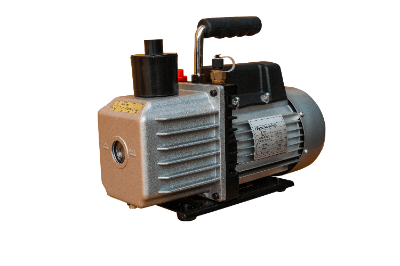What Is a Rotary Pump?

A rotary pump is a pump that can easily achieve a vacuum up to about a medium vacuum (10^-1 Pa).
Officially, they are called oil-sealed rotary vacuum pumps. The main characteristics are as follows:
- Relatively inexpensive (700-2000 USD)
- Compact and easy to install
- Simple structure, easy to use, and easy to maintain
- High exhaust efficiency and large exhaust velocity
- Overall performance is stable
Because they are relatively inexpensive and easy to operate, they have been used in a variety of applications, including scientific research equipment and industrial systems.
Recently, the development of motor-directed, high-speed rotary speed models and their miniaturization have expanded the range of applications. However, conventional belt-applied, low-speed rotary pumps are also used in chemical experiments and in other situations where chemical vapors are suctioned.
Uses of Rotary Pumps
Because rotary pumps are easy to operate and install, they are widely used in situations where a vacuum is required, but a high vacuum is not necessary. Specifically, rotary pumps are used in combination with equipment for scientific experiments that require a vacuum.
They are also often used for initial stage depressurization (roughing) when achieving an ultra-high vacuum, or as a back pump to maintain the back pressure of the entire system. In this use, the large pumping speed is helpful. The compactness and stable performance of rotary pumps are the foundation of their ease of use and fit a wide variety of applications.
Principle of Rotary Pumps
The principle of rotary pumps differs depending on the type.
1. Rotary Blade Oil Rotary Vacuum Pump
The cylinder is divided into three spaces by two blades attached to a rotor built inside the cylinder. The gas in the small chambers divided by the blades is discharged as the rotor rotates, thereby reducing the pressure.
2. Cam Type Oil Rotary Vacuum Pump
A portion of the eccentric rotor installed in the center of the cylindrical stator rotates in contact with the stator. Gas in the space between the stator and the rotor is discharged, resulting in a progressive decompression.
3. Oscillating Piston Type Oil Rotary Vacuum Pump
Rotation of the eccentric rotor causes the piston to move up and down. The piston compresses and discharges the expected pressure inside the cylinder, thereby reducing pressure.
All of these types of rotary pumps use oil to lubricate and cool the bearings and to make the inside of the pump airtight. This is why they are called oil rotary vacuum pumps.
How to Select Rotary Pumps
When selecting a rotary pump, the following three points should be considered.
1. The Degree of Vacuum to Be Achieved
The most important factor in selecting a rotary pump is whether the vacuum you want to achieve matches the performance of the model. Among rotary pumps, the two-stage type can achieve a high vacuum.
2. Power Supply
For easy outdoor use, a battery-powered type is convenient. For example, when suctioning refrigerant during the installation of an air conditioner.
For stationary use, a power supply type is used. Most of them use single-phase AC 100V, but some models for industrial use 3-phase AC.
3. Oil Backflow Prevention Function
When operation stops during work, such as when a power failure occurs during vacuuming, oil is sucked from the rotary pump to the vacuum side and flows out. The same thing will happen if the decompression release is insufficient during stop operation. Therefore, the availability of a back-flow prevention mechanism to prevent this is also an important selection point.
Other Information on Rotary Pumps
1. Generation of Oil Mist and Its Effects
Since rotary pumps use oil, oil mist will inevitably fly to the exhaust side. Also, a very small amount of oil will be blown up to the vacuum side as a mist. If you do not want oil mist to mix with the vacuum, you should consider an oil-free pump instead of an oil rotary pump.
When disposing of combustible or tributary gases (oxygen), oil mist may explode on the exhaust side in a phenomenon similar to a dust explosion. When exhausting such gases, it is recommended to use inert oil (e.g., oil of halogenated hydrocarbons) as the oil.
2. Effects of Gas Ballast Operation
During depressurization, a small amount of condensate (water, organic solvents, etc.) contained in the aspirated gas will accumulate in the oil. If left untreated, the oil will not perform as it should, so an operation called gas ballasting is performed to remove it.
When the temperature of the Rotary Pump is sufficiently high, a valve called a gas ballast valve can be opened to volatilize and release the condensate.
3. Necessity of Oil Change
Oil deteriorates gradually and needs to be changed periodically. Generally, the oil should be changed once every six months to a year.